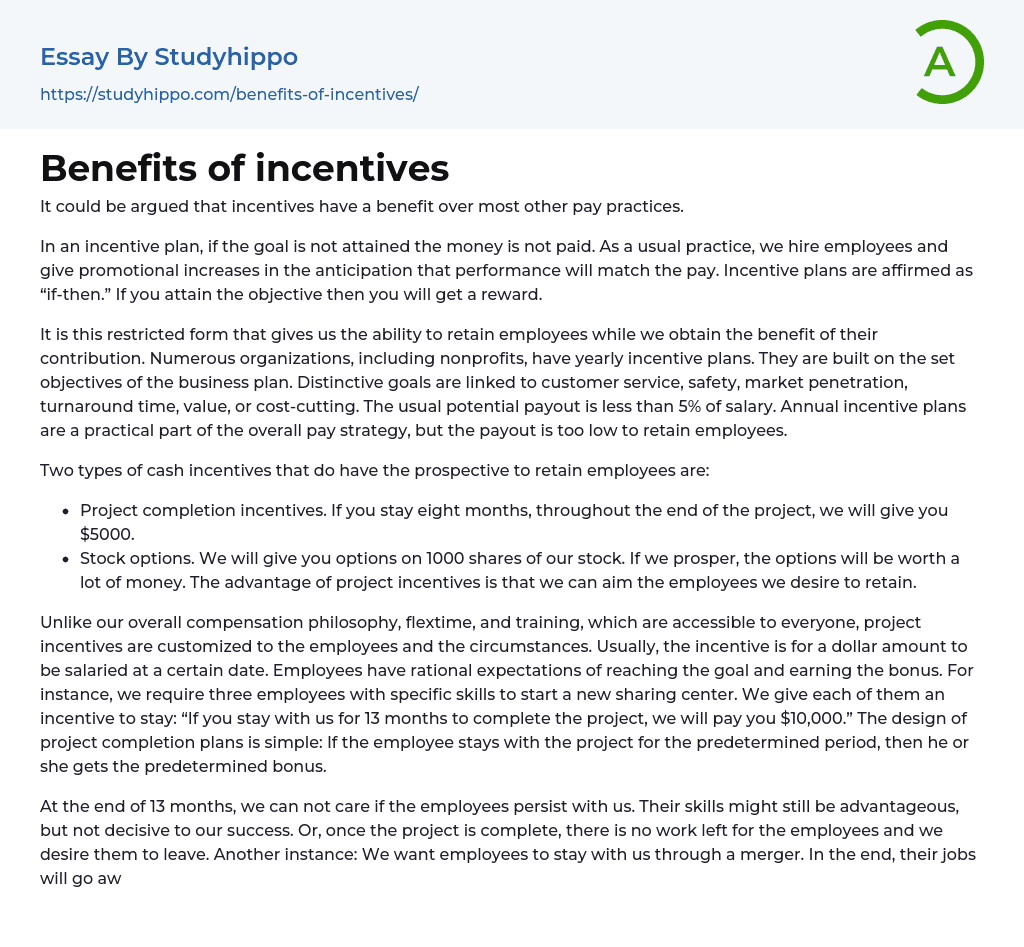Compared to other pay practices, incentives offer advantages. In an incentive plan, money is only given if the goal is achieved. We usually expect employees' performance to align with their pay when hiring and promoting them. Incentive plans follow an "if-then" approach - if the objective is accomplished, a reward will be received. This format helps retain employees and benefit from their contributions effectively. Annual incentive plans are common among various organizations, including nonprofits.
Implemented within the set objectives of the business plan, these incentive plans encompass various distinctive goals such as customer service, safety, market penetration, turnaround time, and value or cost-cutting. However, the usual potential payout amounts to less than 5% of an employee's salary, rendering annual incentive plans insufficient in retaining employees as part of the overall pay strateg
...y.
Two types of cash incentives that have the potential to retain employees are:
- Project completion incentives: If you stay eight months, throughout the end of the project, we will give you $5000.
- Stock options: We will give you options on 1000 shares of our stock. If we prosper, the options will be worth a lot of money. The advantage of project incentives is that we can target the employees we desire to retain.
Unlike our overall compensation philosophy, flextime, and training, which are accessible to everyone, project incentives are customized to the employees and the circumstances. Usually, the incentive is for a dollar amount to be paid at a certain date. Employees have reasonable expectations of achieving the goal and earning the bonus. For instance, we need three employees with specific skills to start a new sharing center.
We provide a
incentive for our employees to stay with us. If they remain on the project for 13 months, they will receive a $10,000 bonus. Our plan is simple: if an employee completes the project within the specified timeframe, they will be rewarded with the predetermined bonus. After 13 months, whether or not employees choose to continue working with us is irrelevant. Although their skills may still be valuable, they are no longer essential to our success. Conversely, if the project is completed, there is no longer a need for employees and we prefer them to leave. However, in the event of a merger taking place, we do want employees to stay with us.
There is a risk of job loss for employees as stock options can result in either wealth or worthlessness. While previously limited to high-ranking executives, now more employees in lower positions are being given this benefit in certain companies.
An option is a financial instrument that grants the holder the right, without any obligation, to purchase a specific stock at a predetermined price referred to as the exercise price. The option itself does not have any inherent value. However, once the market price of the underlying stock exceeds the exercise price, its value increases. When a company performs well, there is an increase in demand for its stock. As a result, employees can use their options to buy the stock at the exercise price and then sell it for profit. This leads to a gain equal to the difference between the market price and exercise price.
Employees usually must be on the payroll while exercising their options to motivate them with stock options. This motivation
stems from the possibility of a potential increase in stock price, enabling them to sell the stock and generate profits. Despite accounts depicting competitive employees utilizing manipulative tactics for career advancement (Petersen, 1988, p. A1), competition also plays a significant role in the workplace. However, Lipman-Blumen (1988) noted that women are recognized for their collaborative, contributory, and mentoring behaviors (pp.24 - 25).
In a survey, almost all of the women interviewed (20 out of 23) stated that there was no competition at work. When asked about any feelings of competition in the workplace, they answered with an immediate and obvious "no." The majority of the respondents emphasized that there was definitely cooperation and they never experienced any sense of competition. Some women described the relationships in the office as characterized by immense loyalty, while others described the atmosphere as having a strong sense of team spirit.
- Money essays
- Financial Accounting essays
- Market Segmentation essays
- Supply And Demand essays
- Purchasing essays
- Forecasting essays
- Legacy essays
- Bank essays
- Corporate Finance essays
- Financial News essays
- Financial Ratios essays
- Financial Services essays
- Free Market essays
- Shareholder essays
- Personal finance essays
- Equity essays
- Financial Crisis essays
- Banking essays
- Credit Card essays
- Currency essays
- Debt essays
- Gold essays
- Loan essays
- Enron Scandal essays
- Foreign Exchange Market essays
- Investment essays
- Venture Capital essays
- Stock Market essays
- Retirement essays
- Donation essays
- Net Present Value essays
- Income Statement essays
- Commercial Bank essays
- Debit Card essays
- Deposit Account essays
- Subprime Lending essays
- Perfect Competition essays
- Underwriting essays
- Synergy essays
- Valuation essays
- Investing essays
- Asset essays
- Depreciation essays
- Discounted Cash Flow essays
- Foreign Direct Investment essays
- Funds essays
- Internal Rate Of Return essays
- Revenue essays
- Day Trading essays
- Futures Trading essays




